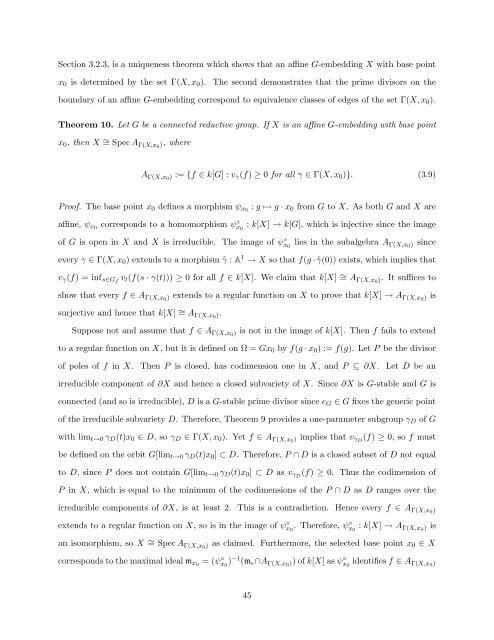Equivariant Embeddings of Algebraic Groups
Equivariant Embeddings of Algebraic Groups
Equivariant Embeddings of Algebraic Groups
You also want an ePaper? Increase the reach of your titles
YUMPU automatically turns print PDFs into web optimized ePapers that Google loves.
Section 3.2.3, is a uniqueness theorem which shows that an affine G-embedding X with base point<br />
x 0 is determined by the set Γ(X, x 0 ). The second demonstrates that the prime divisors on the<br />
boundary <strong>of</strong> an affine G-embedding correspond to equivalence classes <strong>of</strong> edges <strong>of</strong> the set Γ(X, x 0 ).<br />
Theorem 10. Let G be a connected reductive group. If X is an affine G-embedding with base point<br />
x 0 , then X ∼ = Spec A Γ(X,x0 ), where<br />
A Γ(X,x0 ) := {f ∈ k[G] : v γ (f) ≥ 0 for all γ ∈ Γ(X, x 0 )}. (3.9)<br />
Pro<strong>of</strong>. The base point x 0 defines a morphism ψ x0 : g ↦→ g · x 0 from G to X. As both G and X are<br />
affine, ψ x0 corresponds to a homomorphism ψ ◦ x 0<br />
: k[X] → k[G], which is injective since the image<br />
<strong>of</strong> G is open in X and X is irreducible. The image <strong>of</strong> ψ ◦ x 0<br />
lies in the subalgebra A Γ(X,x0 ) since<br />
every γ ∈ Γ(X, x 0 ) extends to a morphism ˜γ : A 1 → X so that f(g · ˜γ(0)) exists, which implies that<br />
v γ (f) = inf s∈Gf v t (f(s · γ(t))) ≥ 0 for all f ∈ k[X]. We claim that k[X] ∼ = A Γ(X,x0 ). It suffices to<br />
show that every f ∈ A Γ(X,x0 ) extends to a regular function on X to prove that k[X] → A Γ(X,x0 ) is<br />
surjective and hence that k[X] ∼ = A Γ(X,x0 ).<br />
Suppose not and assume that f ∈ A Γ(X,x0 ) is not in the image <strong>of</strong> k[X]. Then f fails to extend<br />
to a regular function on X, but it is defined on Ω = Gx 0 by f(g · x 0 ) := f(g). Let P be the divisor<br />
<strong>of</strong> poles <strong>of</strong> f in X. Then P is closed, has codimension one in X, and P ⊆ ∂X. Let D be an<br />
irreducible component <strong>of</strong> ∂X and hence a closed subvariety <strong>of</strong> X. Since ∂X is G-stable and G is<br />
connected (and so is irreducible), D is a G-stable prime divisor since e G ∈ G fixes the generic point<br />
<strong>of</strong> the irreducible subvariety D. Therefore, Theorem 9 provides a one-parameter subgroup γ D <strong>of</strong> G<br />
with lim t→0 γ D (t)x 0 ∈ D, so γ D ∈ Γ(X, x 0 ). Yet f ∈ A Γ(X,x0 ) implies that v γD (f) ≥ 0, so f must<br />
be defined on the orbit G[lim t→0 γ D (t)x 0 ] ⊂ D. Therefore, P ∩ D is a closed subset <strong>of</strong> D not equal<br />
to D, since P does not contain G[lim t→0 γ D (t)x 0 ] ⊂ D as v γD (f) ≥ 0. Thus the codimension <strong>of</strong><br />
P in X, which is equal to the minimum <strong>of</strong> the codimensions <strong>of</strong> the P ∩ D as D ranges over the<br />
irreducible components <strong>of</strong> ∂X, is at least 2. This is a contradiction. Hence every f ∈ A Γ(X,x0 )<br />
extends to a regular function on X, so is in the image <strong>of</strong> ψx ◦ 0<br />
. Therefore, ψx ◦ 0<br />
: k[X] → A Γ(X,x0 ) is<br />
an isomorphism, so X ∼ = Spec A Γ(X,x0 ) as claimed. Furthermore, the selected base point x 0 ∈ X<br />
corresponds to the maximal ideal m x0 = (ψx ◦ 0<br />
) −1 (m e ∩A Γ(X,x0 )) <strong>of</strong> k[X] as ψx ◦ 0<br />
identifies f ∈ A Γ(X,x0 )<br />
45
















